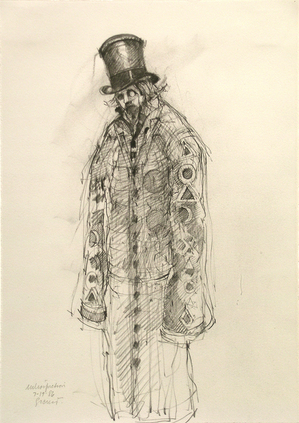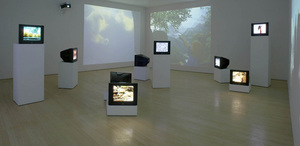This is an archive of the ArtCat Zine, 2007-2009. Please visit our new project, IDIOM.
Recently by Christopher Reiger
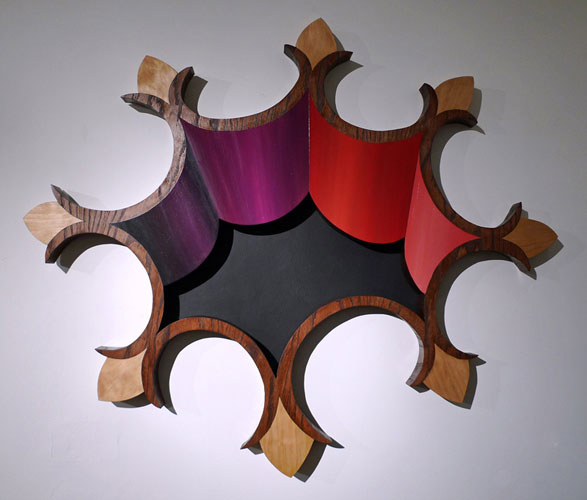
Towers and Portals
Rachel Beach
7 March - 12 April 2009
Show has been extended
Towers and Portals, at Like the Spice Gallery, is Rachel Beach's second solo exhibition in New York. Beach's seductive sculpture-paintings are postmodern, playful explorations of relativistic perception. Using oil paint and a technique called veneered marquetry, the artist creates trompe-l'oeil forms that easily segue from a two-dimensional to a three-dimensional reading and likewise maneuver between ornamentation and cleverly subversive commentary. Remarkably, the works are as sincere as they are arch.
Impressed with her previous solo effort, Chicken & Egg, at HQ Gallery, I worried that Towers and Portals might evidence a sophomore slump. Happily, Beach avoids that pitfall. Although this nit-picky viewer did notice two instances of hurried handiwork -- some uneven paint on the exhibition centerpiece, The Mothership, and stray paint spotting above Benevolent Universe (yellow and pink) - the large and varied collection of sculptural works on hand at Like the Spice is generally first-rate. In fact, it was Beach's superior craft that compelled me to search for defects in the first place.
Tom Secrest
Curated by Trenton Doyle Hancock
CUE Art Foundation - 511 W 25 St, New York NY
31 January - 8 March 2008
In my late teens, I regularly produced drawings of a tall, lean figure dressed in a tail suit and top hat. His facial features were usually obscured, but he glared at the viewer from under a heavy brow. I identified this character as a manifestation of my super ego, and I dubbed him The Observer. I produced at least a hundred such drawings in charcoal or soft-leaded pencil, working the darks into the paper until my fingers blackened. In hindsight, these drawings (and the imagination that spawned them) seem puerile and narcissistic, yet as I made my way around CUE Art Foundation's exhibition of drawings, paintings and prints by Louisiana-based artist Tom Secrest, I recalled that period of self-absorption almost wistfully.
The bulk of Secrest's recent works include a self portrait, either as the central focus or alongside the ghouls, skulls and angels that regularly appear in his compelling pictures. He depicts himself as a morose Shakespeare-type, with a prominent pate, wispy white mane, withdrawn eyes, and, sometimes, a top hat. The images are brooding and often aggressive, rendered with an obsessively graphic sensibility - the paintings, especially, are dominated by reds, and are most concerned with contour and geometry - and bear titles such as Three Sides of the Self, Introspection, Night Dreams, and even The Observer.
The exhibition is thoughtfully curated by the accomplished young artist Trenton Doyle Hancock, who wisely includes a sampling of Secrest's sketchbooks. The pages of these sketchbooks are crowded with heavily worked conte, pastel, charcoal or pencil drawings, and they provide us with a glimpse into what Secrest describes as his "compulsive image making." On a monitor in a corner of the gallery, Hancock displays a video interview with Secrest, as well as a tour of the artist's home studio. These inclusions are significant, emphasizing how thoroughly integrated Secrest's work and creative environment are. On screen, the sixty-five year old artist shuffles down a hallway hung floor to ceiling with artwork (most of it his) and curiosities: a big-eyed alien doll, top hats, masks, skulls and more. According to Hancock, every room is decorated in this fashion; he refers to the house as "a visionary environment." The overall effect is shrine-like, but Secrest's is a tomb-like shrine, dimly lit and silent, excepting the artist's intermittent cough.
Guy Ben-Ner
5 January - 16 February 2008
Postmasters Gallery - 459 W. 19 St, New York NY
Some naysayers insist that contemporary conceptual art is nothing but illustration of political, philosophical, or ethical concepts already explored (more fully) by academics. The artists, they argue, are rightly excited by these ideas, but then doll up and dumb down the texts that inspired them in order to create something "new," and the commercial art world celebrates them for it. The Israeli artist Guy Ben-Ner, who has in the past decade produced some fine work, is typically exempt from such criticism, but Stealing Beauty, one of two Ben-Ner video works currently on display at Postmasters, is not.
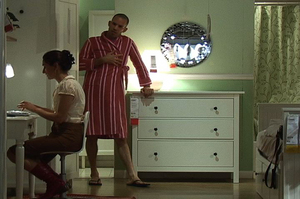
Single channel video DVD, Courtesy Postmasters Gallery
Shot without permission in different IKEA stores near New York, Berlin, and Tel Aviv, "Stealing Beauty" follows the Ben-Ner family through a series of archetypal household routines: returning home from work, showering, surfing the Internet, washing dishes, preparing for bed. Ben-Ner gives these activities a sitcom treatment, right down to the happy, if vaguely maddening, musical jingle used for scene transitions and credits. Watching the family "live" in the IKEA showrooms is as funny as it is unsettling. Viewers will chuckle whenever IKEA shoppers wander into the shot, and some scenes — for example, a rubber-gloved Amir, Ben-Ner's young son, washes imaginary dishes in a kitchen showroom while a puzzled shopper looks on — are satisfying slapstick. Yet every shot is populated with bold IKEA price tags, hanging from the wall sconces, book shelves, lamps and chairs. When Guy and his wife, Nava, get into bed, we can’t ignore a framed photograph of a smiling blonde couple — not Guy and Nava — propped on the night stand. The point is clear: the Ben-Ners, like all of us today (to one degree or another), adopt a manufactured individuality and conform through consumption.
Enrichment
Nina Katchadourian
Sara Metzer Gallery - 525-531 W. 25 St, New York NY
17 November - 22 December 2007
The Hyena and Other Men
Pieter Hugo
Yossi Milo Gallery - 525 W. 25 St, New York NY
29 November 2007 - 12 January 2008
In the summer of 1998, the prolific visual artist and musician Nina Katchadourian used red sewing thread to "repair" damaged spider webs on Porto, an island in the Finnish archipelago. She photographed these repairs immediately after making them, but discovered that the web tenants would overnight extricate her "patch jobs" and fix the web using their silk.
The "Mended Spiderweb" project is typical of Katchadourian's practice; wry humor and whimsy are integral, but an exuberant sense of wonder impels the work. The three works in "Enrichment," Katchadourian's current solo exhibition at Sara Meltzer Gallery, continue in this mode, though they also contemplate a somber side of humanity's relationship with the rest of the animal kingdom.
In Meltzer's upstairs gallery, Katchadourian has arranged wallet-sized pictures of animal species in a linear spectrum that transitions from incredibly cute, at the center, to "uncute," at either extreme. Initially, I thought "Continuum of Cute" worth only a chuckle, but as I reviewed Katchadourian's placement of the various species, I wised to the work's sly reproach. The "cute" animals are most often mammals with large, liquid eyes, those that conservation non-profits choose as their emblems, animation studios turn into cartoon protagonists, and children beg their parents to acquire as house pets. In this respect, Katchadourian's "Continuum of Cute" is not unlike a beauty pageant, but one in which the participants are not being judged by their own kind. The exhibition press release points out that "the entire spectrum is reconfigurable...and therefore hints at the subjective hand that each viewer would bring to" the task but, lest we forget, each of those hands is human.
Nearby, Katchadourian has arranged six televisions in a circle around an exposed, vertical pipe, each screen facing outward. When I ascended the gallery stairs, the two screens facing me were black. After several moments, however, the screen on the right lit up. I watched as an orangutan methodically crossed two suspended cables, moving from right to left. As the ape moved off the left edge of the frame, the next television screen was triggered and, on it, the same clip began anew. After the orangutan passed across the second monitor, he appeared on the third, and so on. Round and round the orangutan goes.
3 Modifications
Brody Condon
Virgil de Voldere Gallery - 526 W. 26 St, New York NY
15 November 2007 - 15 December 2007
As a teenager in search of amusing diversion, I occasionally tinkered with the programming code of popular computer games. Doing so required no expertise. I only had to augment or edit source files in directories associated with the game and then run the program. The results were unexpected and often bizarre: characters appeared headless and walked on air or the game scenery lay flat, rendered incomplete in crude polygons. My monkeying was primitive, random and pointless, but always satisfying. Because of my familiarity with basic game modifications ("mods," for short), I'm skeptical and dismissive of most such works appearing in contemporary art galleries. Brody Condon's sly gaming "interventions" and mods are an exception.
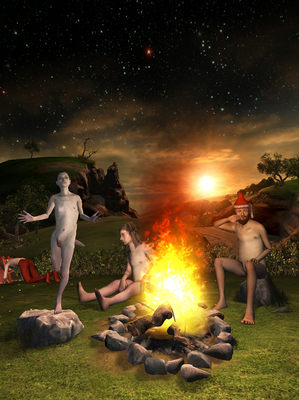
Self-playing computer game, custom computer.
Courtesy Virgil de Voldere.
In 2001, Condon repeatedly prostrated his character in Anarchy Online, a massively multiplayer online game. Condon's ritualistic worship of the omnipotent player (and viewer) takes place in an open square; around his character, fellow gamers move, engaged in more conventional, prescribed actions. For 2004's "Suicide Solution," Condon documented character suicides in over 50 first and third person shooters. Both gestures are artless, to be sure, but Condon's commitment to the virtual act ennobles the short documentaries; farce is transformed into pathos.
Neither "Worship" nor "Suicide Solution" are true mods, but KarmaPhysics{Ram Dass, created in 2005, qualifies. For this video projection, Condon reworks files and graphics from the game Unreal 2003 to produce a suspended, writhing pile of clones. As with his earlier projects, KarmaPhysics{Ram Dass transcends a simple premise, in this case becoming a hypnotic meditation on intellectual, physical and emotional suffering.
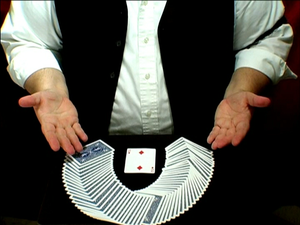
Courtesy of the artist and Gavlak Projects, West Palm Beach
The Visitors
Jose Alvarez
1 November - 22 December 2007
The Kitchen - 512 W. 19th St., New York NY
Lenore Malen
6 September - 13 October 2007
CUE Art Foundation - 511 W. 25th St., New York NY
In her 2003 essay, "Cults and Cosmic Consciousness," critic Camille Paglia likens our contemporary sociopolitical climate to the upheaval experienced in both late Hellenistic and imperial Roman times. Paglia reckons that the proliferation of cults, a phenomenon common to all three eras, is symptomatic "of cultural fracturing in cosmopolitan periods of rapid expansion and mobility." Rather than envisioning 1960s-style alternatives - however flawed - to the status quo (a la Timothy Leary's "turn on, tune in, and drop out"), the disillusioned among us today turn on and tune out by embracing the culture of distraction. But celebrity worship, cinematic spectacle, and hyper consumerism fail to satisfy deep spiritual needs and signs of our want are abundant in popular culture: television programs feature paranormal investigators, mediums, and psychics; horoscopes are a staple of newspapers; religious fundamentalism is experiencing significant surges in popularity.
Yet western academics and arbiters of high culture have for the last thirty years dismissed projects that esteem religiosity or the occult. Adolescent and iconoclastic efforts critiquing, attacking or lampooning religion were accepted, but devotional or faith-oriented works were rarely printed or exhibited by mainstream publishers or galleries. Fortunately, we are beginning to jettison the self-conscious rhetoric and cynicism of late 20th century philosophy and critical thinking. As a result, contemporary artists address our spiritual void more honestly and, in doing so, they often draw on the social experiments and ideologies of the 1960s and 70s. Psychedelic painting is appearing in galleries, as is an affection for pagan or pantheistic metaphysics and ritual magic, cornerstones of cultism.
Cultism is a natural outgrowth of human society. It can be denied, but never abolished. Indeed, though mainstream media outlets and academic institutions continue to frown on articles or expressions of deep faith, most of the world's population, ours included, identifies as "religious." The truly global citizen must relearn (or at least learn to respect) the value of sacred symbols and rites. But can we also learn to accept spiritual plurality? Is cultic belief fundamentally anathema to pluralism? Are we sophisticated enough to discern between "real" spirituality and the quick con or, more seriously, demagoguery? These questions are central to the projects of two artists about whom more should be known, Jose Alvarez and Lenore Malen.
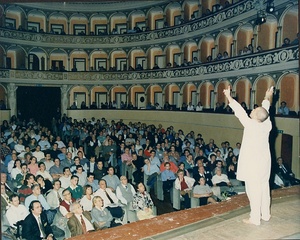
Courtesy of the artist and Gavlak Projects, West Palm Beach
In his current solo exhibition, The Visitors, at The Kitchen, Alvarez includes some documentation of the Carlos project, but most of the work on display is more recent. Two videos call attention to the illusion sold credulous audiences by skillful magicians and mediums. One of these, The Guessing Game, is a montage of television appearances by "survival evidence medium," James Van Praagh. Van Praagh uses time-honored tricks of the trade to appeal to his subject's desire to "communicate" with a lost loved one. Most often, he supplies a generality, couched in ambiguous language, and the subject, determined to believe, faithfully fills in the details. To illustrate the extent of the mediums' chicanery, Alvarez edits Guessing Game in a manner similar to that which filmmaker Robert Greenwald used for his documentary, Outfoxed, a rapid cut, propagandistic style that manipulates the viewer in much the same way the artists' respective targets manipulate their subject or audience.
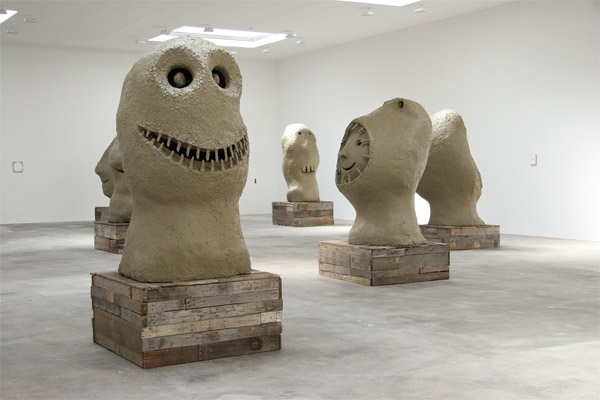
Gallery, New York, September 13 to October 27, 2007.
Big Mind Sky
Ugo Rondinone
Matthew Marks Chelsea - 522 West 22nd Street New York, NY
15 September - 27 October 2007
Small graphite drawings on gessoed linen bound the gallery walls and twelve substantial sculptures rise from the gallery floor in Ugo Rondinone's exhibition, Big Mind Sky, at Matthew Marks. Upon entering the space, viewers gravitate to the large forms, each a disembodied head set atop a wooden plinth. The heads are reminiscent of Easter Island's great moai and ahu constructions, but whereas the Polynesian statues were erected in formation, facing inland from the coast to survey various island chiefdoms, Rondinone's sculptures are arranged arbitrarily. The sculptures may be considered a response to modernism's cannibalism of the "primitive," but the artist titled the series "Moonrise" and named each of the expressive heads after a month of the year; his ambition, I feel, is more profound.
Oceans Between Us
Adam Ogilvie
Josee Bienvenu Gallery
20 September - 27 October 2007
The geology of Adam Ogilvie's candy-pop colored landscapes is all marshmallow and lollipop, but a palpable unease pervades his work. In "Wishes for a Wiser time," grey smoke puffs from a volcanic mountain into the pink sky; are these signs of impending eruption? A parachute drops behind a broad hill in "Homes become Hollows, Hollows Become Home," the pilot unseen and unaccounted for; what has happened? In "Fjord," fighter planes sit unattended on quiet plateaus; will they be manned and, if so, to what end?
The inhabitants of this anxiety-ridden world are "MOLEBEARBIRD - burrower, fighter, flyer and hibernator" and a cast of related characters wearing capes, dragging great rocks, and generally going about the business of the absurd. Ogilvie also includes in the exhibit cardboard-and-screw sculptures of these anthropomorphic creatures. Removed from the context of the paintings, the blank-faced sculptures might read as ambivalent totems to our existential folly, but here these creatures appear hopeful, if pensive; they are determined to make the best of every rolling of the bones. Like Camus's Sisyphus, "the struggle itself is enough to fill" these creatures' hearts.
ZINE
HOME
TIPS / COMMENTS
CATEGORIES
CONTRIBUTORS
- Greg Afinogenov
- B. Blagojevic
- Adda Birnir
- Susannah Edelbaum
- Julie Fishkin
- Paddy Johnson
- Jessica Loudis
- Christopher Reiger
- Andrew Robinson
- Peter J. Russo
- Blythe Sheldon
- S.C.Squibb
- Hrag Vartanian

